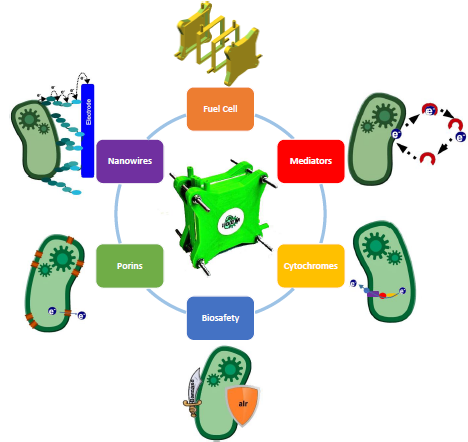Team:Bielefeld-Germany/Project/Abstract
From 2013.igem.org
| Line 73: | Line 73: | ||
<p align="justify"> | <p align="justify"> | ||
| - | + | Over 100 years ago the British botanist M. C. Potter discovered electro-chemical reactions by anaerobe microbial degradation processes. This was the milestone for the first ideas of developing biological degradation systems for electricity generation. Today, there is a growing interest in the use of ecologically friendly alternative energy sources because of the depletion of fossil fuels and an increasing environmental pollution. Therefore, iGEM-Team Bielefeld is developing an ''Escherichia coli'' based Microbial Fuel Cell (MFC). | |
| - | + | ||
| - | The | + | |
| + | The goal of our project is to generate electrical energy with a genetically modified ''Escherichia coli'' in a self-constructed fuel cell. Besides the design, construction and technical optimization of the fuel cell, we investigate different genetic approaches. Using synthetic biology, we are designing different BioBricks for bioelectricity generation. Specific electron transfer proteins have been compiled from a variety of organisms, in order to gain an ''Escherichia coli'' Fuel Cell platform, which turns ''E. coli'' to an electro active organism. | ||
| + | The main challenge is due to an efficient electron transfer from the bacteria to the electrode. Therefore we facilitate and improve electron donation by producing electron-shuttles, so called endogenous mediators, as well as permeabilizing the cell surface by integrating large membrane porins and providing a direct electron pathway by conductive transmembrane protein structures. All these electron transport elements increase electron transfer and bioelectricity generation. | ||
| + | |||
| + | |||
| + | With different aspects for technical and genetic optimization we enable ''E''co''lectricity'', the use of ''E. coli'' for direct energy production. Furthermore we formed a biosafety concept to use our Microbial Fuel Cell not only in the laboratory, but also in the future as a safe alternative energy source in the environment for numerous and manifold of electronic applications. | ||
| + | |||
</p> | </p> | ||
Revision as of 23:43, 3 October 2013
Project
Overview
Over 100 years ago the British botanist M. C. Potter discovered electro-chemical reactions by anaerobe microbial degradation processes. This was the milestone for the first ideas of developing biological degradation systems for electricity generation. Today, there is a growing interest in the use of ecologically friendly alternative energy sources because of the depletion of fossil fuels and an increasing environmental pollution. Therefore, iGEM-Team Bielefeld is developing an Escherichia coli based Microbial Fuel Cell (MFC). The goal of our project is to generate electrical energy with a genetically modified Escherichia coli in a self-constructed fuel cell. Besides the design, construction and technical optimization of the fuel cell, we investigate different genetic approaches. Using synthetic biology, we are designing different BioBricks for bioelectricity generation. Specific electron transfer proteins have been compiled from a variety of organisms, in order to gain an Escherichia coli Fuel Cell platform, which turns E. coli to an electro active organism. The main challenge is due to an efficient electron transfer from the bacteria to the electrode. Therefore we facilitate and improve electron donation by producing electron-shuttles, so called endogenous mediators, as well as permeabilizing the cell surface by integrating large membrane porins and providing a direct electron pathway by conductive transmembrane protein structures. All these electron transport elements increase electron transfer and bioelectricity generation. With different aspects for technical and genetic optimization we enable Ecolectricity, the use of E. coli for direct energy production. Furthermore we formed a biosafety concept to use our Microbial Fuel Cell not only in the laboratory, but also in the future as a safe alternative energy source in the environment for numerous and manifold of electronic applications.
MFC
Exogenous Mediators
Mediators are essential for the use of Escherichia coli in Microbial Fuel Cells. The main advantage of improving MFCs is to enhance kinetics of the electron transfer between the bacterial cells and the fuel cell anode. Enhancing the mediator concentration in the MFC is an efficient way for higher electron transfer. In order to decrease the usage of expensive and toxic synthetic mediators, we engineered an E. coli KRX strain with overexpression of glycerol dehydrogenase (GldA). GldA produces the endogenous mediator NADH from NAD+ and glycerol, which is the main carbon source of our medium. Optimized E. coli produces efficient mediators. Read more about our subproject GldA, of the theory behind, the genetic approach, to the results.
Glycerol dehydrogenase
Riboflavin
Phenazine
Porins
A major limiting factor of electron transfer to the electrode and efficient bioelectricity generation is the low bacterial membrane permeability, limiting transport of electron shuttles through the membrane that restricts the electron shuttle-mediated extracellular electron transfer (EET). This results in a reduced electrical power output of the MFC. Therefore, we heterologously expressed the porin protein OprF from Pseudomonas fluorescens into Escherichia coli with great success. Read more about our subproject porins, of the theory behind, the genetic approach, to the results.
Cytochromes
Cell membranes work as a natural insulator and prevent the flow from electrons out of the cell. To enable transfer of electrons from the general metabolism to the outside of the cell a minimal set of genes, coding for the periplasmatic decaheme MtrA, the outer membrane β-barrel protein MtrB and the outer membrane cytochromes MtrC was isolated from Shewanella oneidensis MR-1 and heterologously expressed in E. coli. Read more about our subproject cytochromes, the theory behind it, the genetic approach and the results.
Nanowires
Biosafety
 "
"





